Digital Marketing and Consumer Behavior in China and India
VerifiedAdded on 2023/04/20
|22
|9264
|408
Report
AI Summary
This literature review examines the significant impact of digital marketing on consumer behavior in China and India, focusing on how globalization and the rise of Web 2.0 have reshaped purchasing habits. The report analyzes 15 peer-reviewed articles to understand the changing landscape of digital marketing strategies, consumer engagement, and the influence of disposable income. The findings highlight a shift towards digital media for meeting consumer needs, particularly in developing countries. The research acknowledges limitations, such as the lack of in-depth analysis of current trends, while emphasizing the value of accumulated data on consumer behavior changes over the past decade. The study provides insights into the evolving digital marketing landscape and its effects on consumer behavior in China and India.
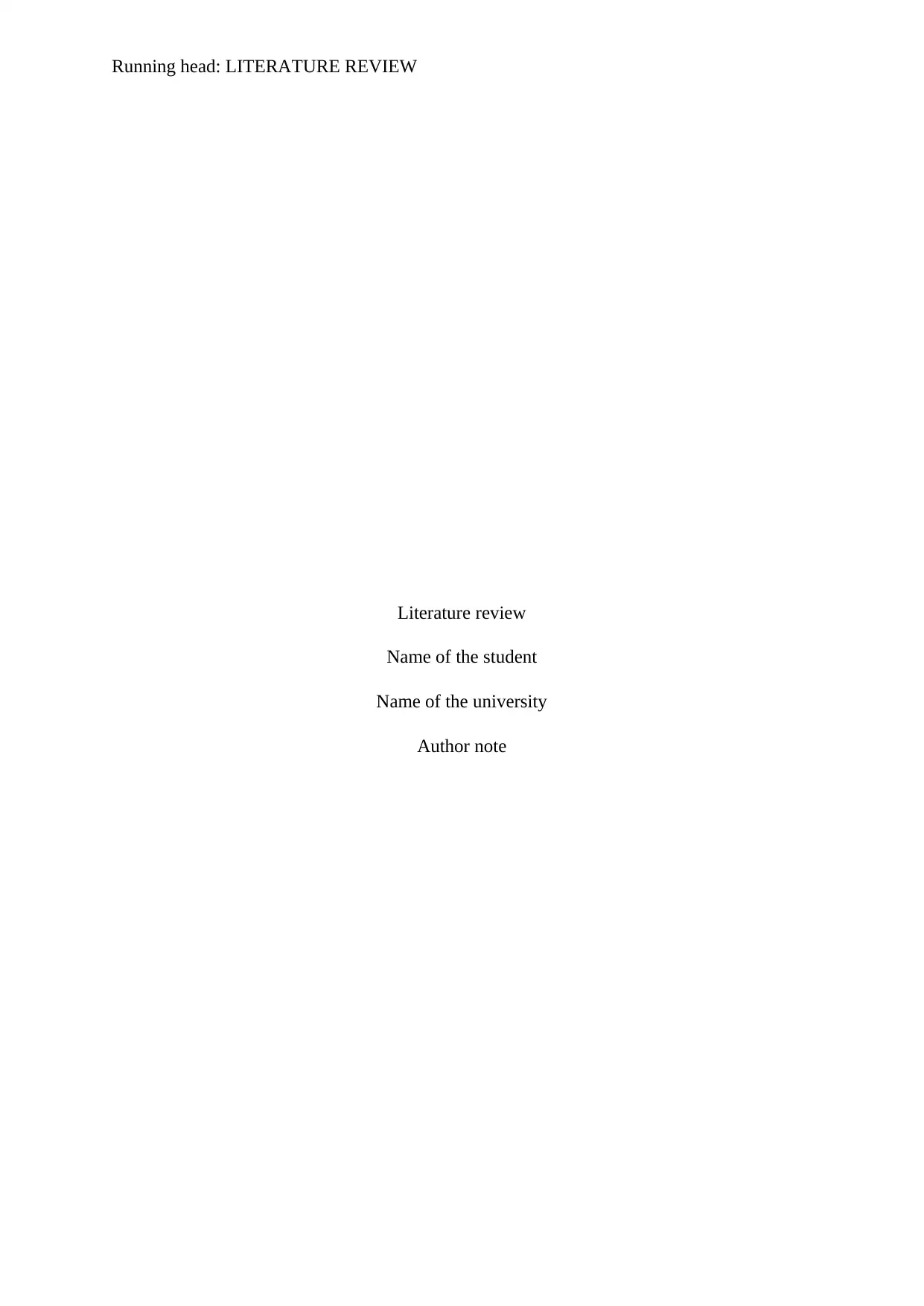
Running head: LITERATURE REVIEW
Literature review
Name of the student
Name of the university
Author note
Literature review
Name of the student
Name of the university
Author note
Paraphrase This Document
Need a fresh take? Get an instant paraphrase of this document with our AI Paraphraser
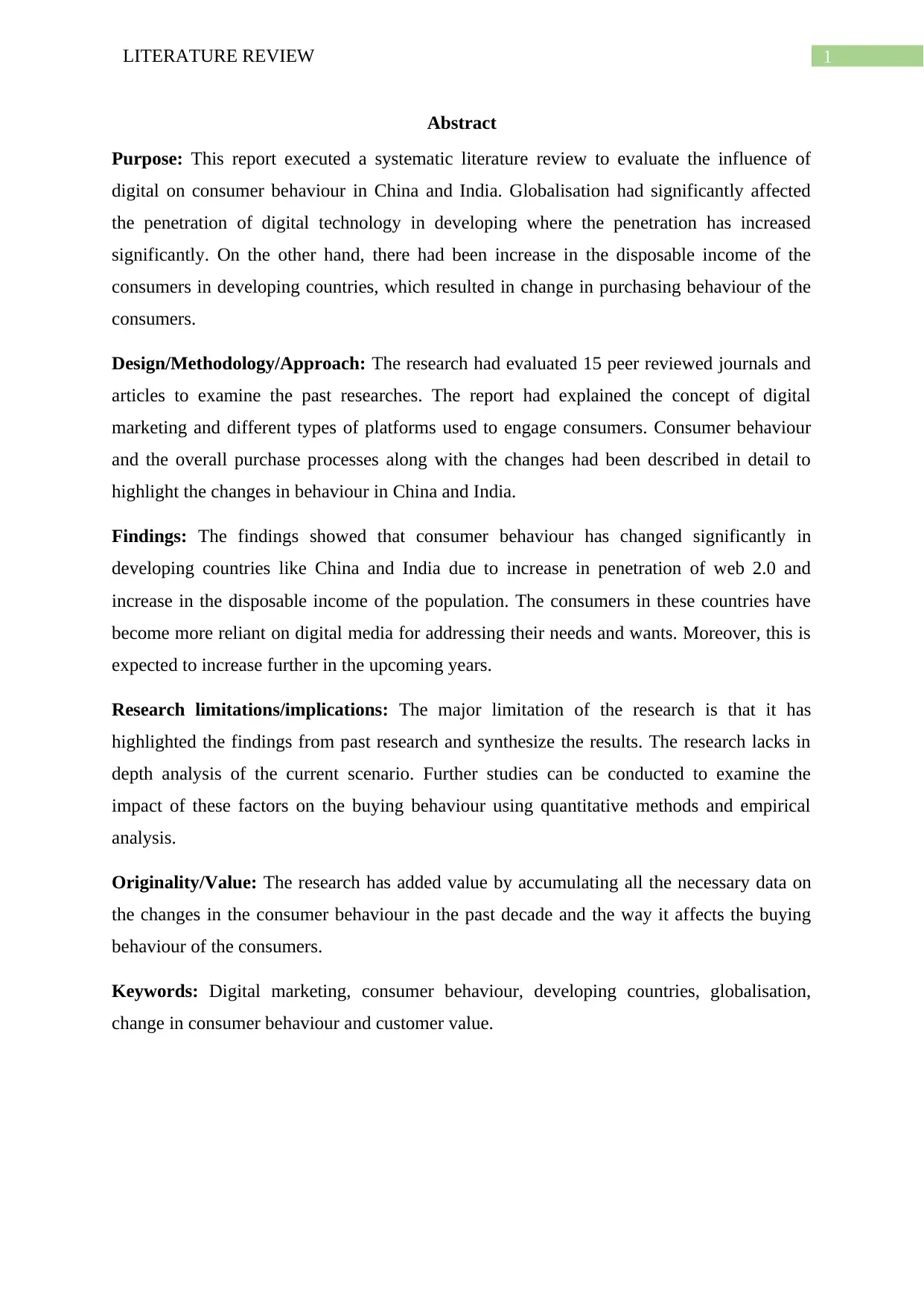
1LITERATURE REVIEW
Abstract
Purpose: This report executed a systematic literature review to evaluate the influence of
digital on consumer behaviour in China and India. Globalisation had significantly affected
the penetration of digital technology in developing where the penetration has increased
significantly. On the other hand, there had been increase in the disposable income of the
consumers in developing countries, which resulted in change in purchasing behaviour of the
consumers.
Design/Methodology/Approach: The research had evaluated 15 peer reviewed journals and
articles to examine the past researches. The report had explained the concept of digital
marketing and different types of platforms used to engage consumers. Consumer behaviour
and the overall purchase processes along with the changes had been described in detail to
highlight the changes in behaviour in China and India.
Findings: The findings showed that consumer behaviour has changed significantly in
developing countries like China and India due to increase in penetration of web 2.0 and
increase in the disposable income of the population. The consumers in these countries have
become more reliant on digital media for addressing their needs and wants. Moreover, this is
expected to increase further in the upcoming years.
Research limitations/implications: The major limitation of the research is that it has
highlighted the findings from past research and synthesize the results. The research lacks in
depth analysis of the current scenario. Further studies can be conducted to examine the
impact of these factors on the buying behaviour using quantitative methods and empirical
analysis.
Originality/Value: The research has added value by accumulating all the necessary data on
the changes in the consumer behaviour in the past decade and the way it affects the buying
behaviour of the consumers.
Keywords: Digital marketing, consumer behaviour, developing countries, globalisation,
change in consumer behaviour and customer value.
Abstract
Purpose: This report executed a systematic literature review to evaluate the influence of
digital on consumer behaviour in China and India. Globalisation had significantly affected
the penetration of digital technology in developing where the penetration has increased
significantly. On the other hand, there had been increase in the disposable income of the
consumers in developing countries, which resulted in change in purchasing behaviour of the
consumers.
Design/Methodology/Approach: The research had evaluated 15 peer reviewed journals and
articles to examine the past researches. The report had explained the concept of digital
marketing and different types of platforms used to engage consumers. Consumer behaviour
and the overall purchase processes along with the changes had been described in detail to
highlight the changes in behaviour in China and India.
Findings: The findings showed that consumer behaviour has changed significantly in
developing countries like China and India due to increase in penetration of web 2.0 and
increase in the disposable income of the population. The consumers in these countries have
become more reliant on digital media for addressing their needs and wants. Moreover, this is
expected to increase further in the upcoming years.
Research limitations/implications: The major limitation of the research is that it has
highlighted the findings from past research and synthesize the results. The research lacks in
depth analysis of the current scenario. Further studies can be conducted to examine the
impact of these factors on the buying behaviour using quantitative methods and empirical
analysis.
Originality/Value: The research has added value by accumulating all the necessary data on
the changes in the consumer behaviour in the past decade and the way it affects the buying
behaviour of the consumers.
Keywords: Digital marketing, consumer behaviour, developing countries, globalisation,
change in consumer behaviour and customer value.
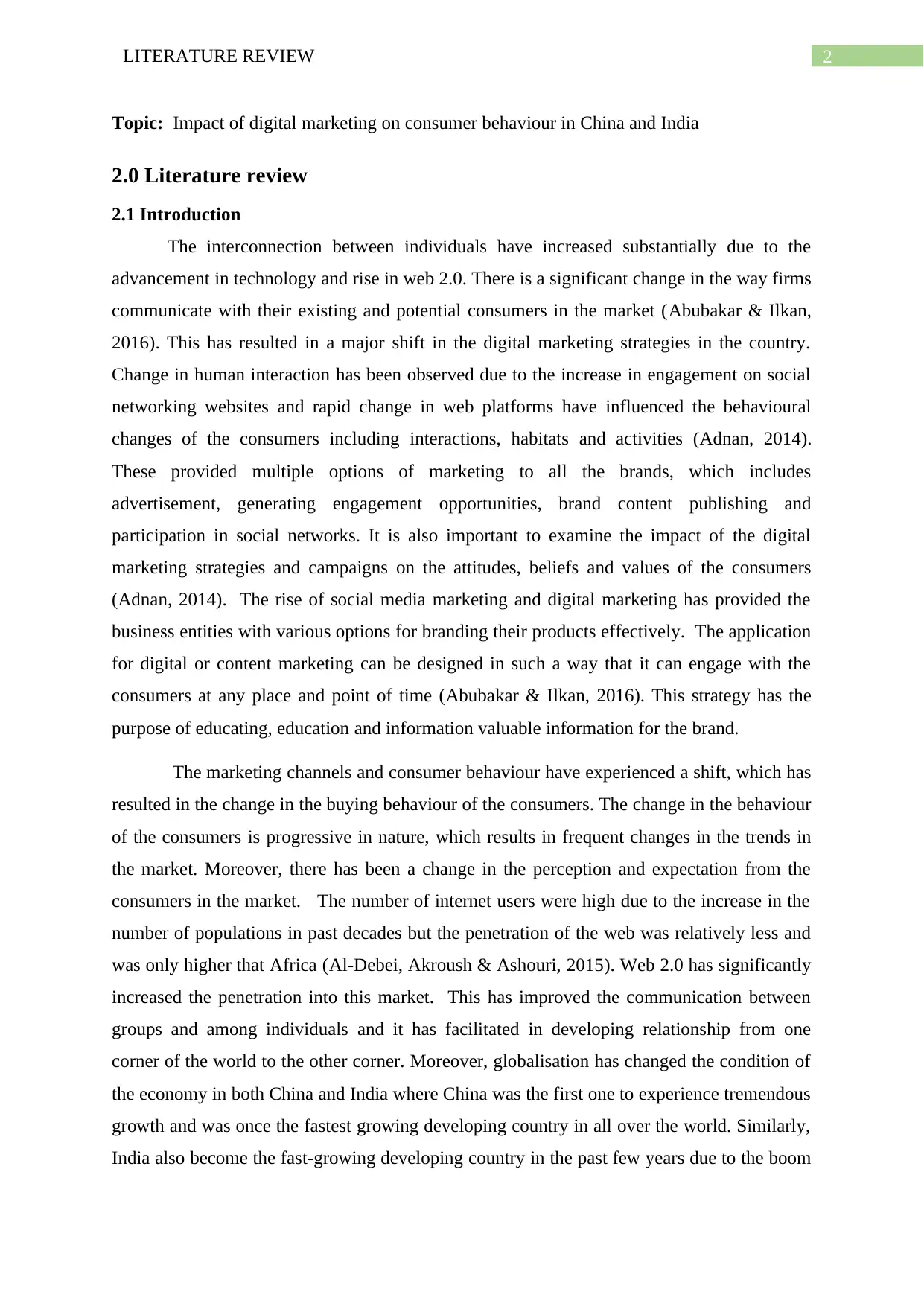
2LITERATURE REVIEW
Topic: Impact of digital marketing on consumer behaviour in China and India
2.0 Literature review
2.1 Introduction
The interconnection between individuals have increased substantially due to the
advancement in technology and rise in web 2.0. There is a significant change in the way firms
communicate with their existing and potential consumers in the market (Abubakar & Ilkan,
2016). This has resulted in a major shift in the digital marketing strategies in the country.
Change in human interaction has been observed due to the increase in engagement on social
networking websites and rapid change in web platforms have influenced the behavioural
changes of the consumers including interactions, habitats and activities (Adnan, 2014).
These provided multiple options of marketing to all the brands, which includes
advertisement, generating engagement opportunities, brand content publishing and
participation in social networks. It is also important to examine the impact of the digital
marketing strategies and campaigns on the attitudes, beliefs and values of the consumers
(Adnan, 2014). The rise of social media marketing and digital marketing has provided the
business entities with various options for branding their products effectively. The application
for digital or content marketing can be designed in such a way that it can engage with the
consumers at any place and point of time (Abubakar & Ilkan, 2016). This strategy has the
purpose of educating, education and information valuable information for the brand.
The marketing channels and consumer behaviour have experienced a shift, which has
resulted in the change in the buying behaviour of the consumers. The change in the behaviour
of the consumers is progressive in nature, which results in frequent changes in the trends in
the market. Moreover, there has been a change in the perception and expectation from the
consumers in the market. The number of internet users were high due to the increase in the
number of populations in past decades but the penetration of the web was relatively less and
was only higher that Africa (Al-Debei, Akroush & Ashouri, 2015). Web 2.0 has significantly
increased the penetration into this market. This has improved the communication between
groups and among individuals and it has facilitated in developing relationship from one
corner of the world to the other corner. Moreover, globalisation has changed the condition of
the economy in both China and India where China was the first one to experience tremendous
growth and was once the fastest growing developing country in all over the world. Similarly,
India also become the fast-growing developing country in the past few years due to the boom
Topic: Impact of digital marketing on consumer behaviour in China and India
2.0 Literature review
2.1 Introduction
The interconnection between individuals have increased substantially due to the
advancement in technology and rise in web 2.0. There is a significant change in the way firms
communicate with their existing and potential consumers in the market (Abubakar & Ilkan,
2016). This has resulted in a major shift in the digital marketing strategies in the country.
Change in human interaction has been observed due to the increase in engagement on social
networking websites and rapid change in web platforms have influenced the behavioural
changes of the consumers including interactions, habitats and activities (Adnan, 2014).
These provided multiple options of marketing to all the brands, which includes
advertisement, generating engagement opportunities, brand content publishing and
participation in social networks. It is also important to examine the impact of the digital
marketing strategies and campaigns on the attitudes, beliefs and values of the consumers
(Adnan, 2014). The rise of social media marketing and digital marketing has provided the
business entities with various options for branding their products effectively. The application
for digital or content marketing can be designed in such a way that it can engage with the
consumers at any place and point of time (Abubakar & Ilkan, 2016). This strategy has the
purpose of educating, education and information valuable information for the brand.
The marketing channels and consumer behaviour have experienced a shift, which has
resulted in the change in the buying behaviour of the consumers. The change in the behaviour
of the consumers is progressive in nature, which results in frequent changes in the trends in
the market. Moreover, there has been a change in the perception and expectation from the
consumers in the market. The number of internet users were high due to the increase in the
number of populations in past decades but the penetration of the web was relatively less and
was only higher that Africa (Al-Debei, Akroush & Ashouri, 2015). Web 2.0 has significantly
increased the penetration into this market. This has improved the communication between
groups and among individuals and it has facilitated in developing relationship from one
corner of the world to the other corner. Moreover, globalisation has changed the condition of
the economy in both China and India where China was the first one to experience tremendous
growth and was once the fastest growing developing country in all over the world. Similarly,
India also become the fast-growing developing country in the past few years due to the boom
⊘ This is a preview!⊘
Do you want full access?
Subscribe today to unlock all pages.

Trusted by 1+ million students worldwide
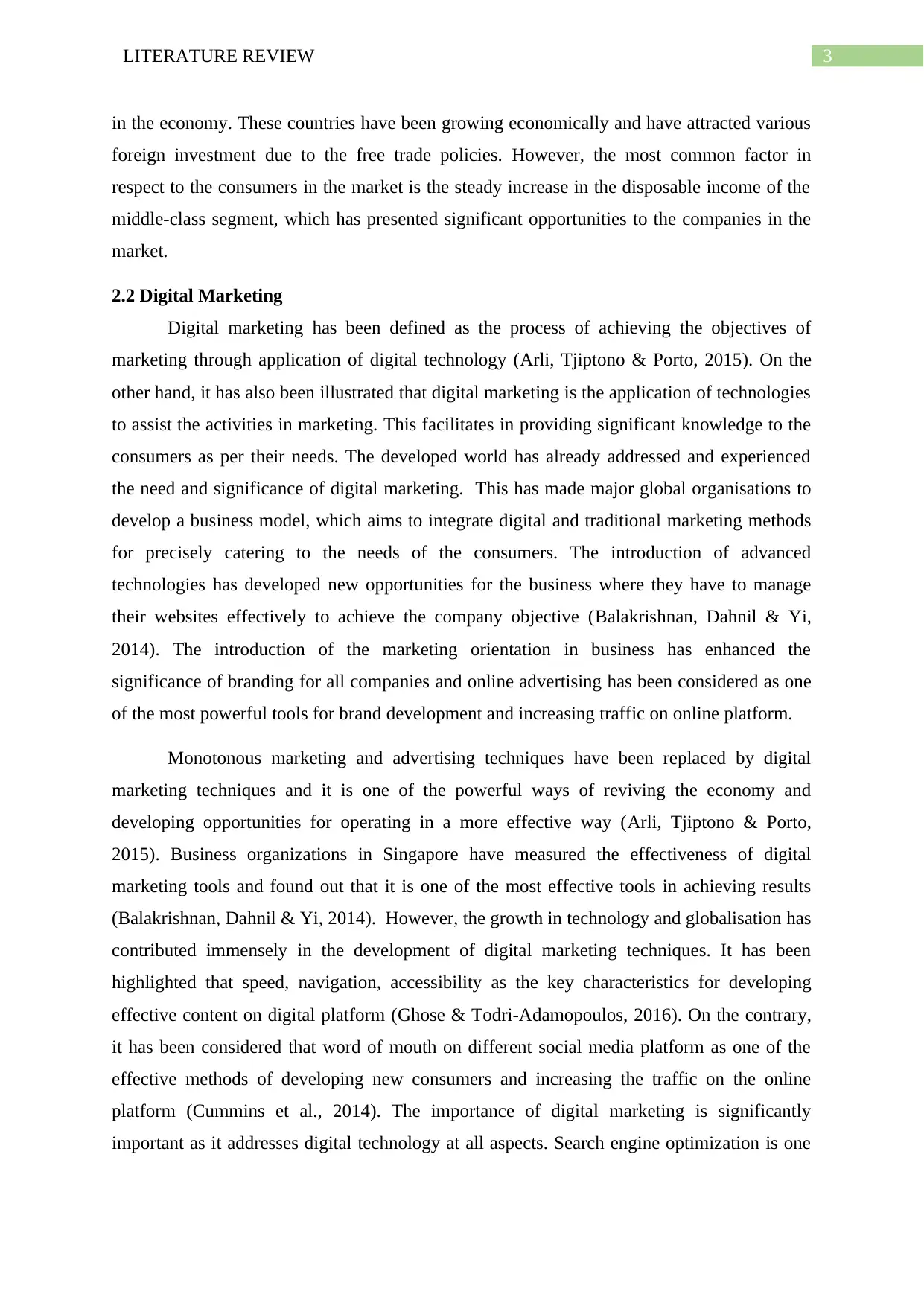
3LITERATURE REVIEW
in the economy. These countries have been growing economically and have attracted various
foreign investment due to the free trade policies. However, the most common factor in
respect to the consumers in the market is the steady increase in the disposable income of the
middle-class segment, which has presented significant opportunities to the companies in the
market.
2.2 Digital Marketing
Digital marketing has been defined as the process of achieving the objectives of
marketing through application of digital technology (Arli, Tjiptono & Porto, 2015). On the
other hand, it has also been illustrated that digital marketing is the application of technologies
to assist the activities in marketing. This facilitates in providing significant knowledge to the
consumers as per their needs. The developed world has already addressed and experienced
the need and significance of digital marketing. This has made major global organisations to
develop a business model, which aims to integrate digital and traditional marketing methods
for precisely catering to the needs of the consumers. The introduction of advanced
technologies has developed new opportunities for the business where they have to manage
their websites effectively to achieve the company objective (Balakrishnan, Dahnil & Yi,
2014). The introduction of the marketing orientation in business has enhanced the
significance of branding for all companies and online advertising has been considered as one
of the most powerful tools for brand development and increasing traffic on online platform.
Monotonous marketing and advertising techniques have been replaced by digital
marketing techniques and it is one of the powerful ways of reviving the economy and
developing opportunities for operating in a more effective way (Arli, Tjiptono & Porto,
2015). Business organizations in Singapore have measured the effectiveness of digital
marketing tools and found out that it is one of the most effective tools in achieving results
(Balakrishnan, Dahnil & Yi, 2014). However, the growth in technology and globalisation has
contributed immensely in the development of digital marketing techniques. It has been
highlighted that speed, navigation, accessibility as the key characteristics for developing
effective content on digital platform (Ghose & Todri-Adamopoulos, 2016). On the contrary,
it has been considered that word of mouth on different social media platform as one of the
effective methods of developing new consumers and increasing the traffic on the online
platform (Cummins et al., 2014). The importance of digital marketing is significantly
important as it addresses digital technology at all aspects. Search engine optimization is one
in the economy. These countries have been growing economically and have attracted various
foreign investment due to the free trade policies. However, the most common factor in
respect to the consumers in the market is the steady increase in the disposable income of the
middle-class segment, which has presented significant opportunities to the companies in the
market.
2.2 Digital Marketing
Digital marketing has been defined as the process of achieving the objectives of
marketing through application of digital technology (Arli, Tjiptono & Porto, 2015). On the
other hand, it has also been illustrated that digital marketing is the application of technologies
to assist the activities in marketing. This facilitates in providing significant knowledge to the
consumers as per their needs. The developed world has already addressed and experienced
the need and significance of digital marketing. This has made major global organisations to
develop a business model, which aims to integrate digital and traditional marketing methods
for precisely catering to the needs of the consumers. The introduction of advanced
technologies has developed new opportunities for the business where they have to manage
their websites effectively to achieve the company objective (Balakrishnan, Dahnil & Yi,
2014). The introduction of the marketing orientation in business has enhanced the
significance of branding for all companies and online advertising has been considered as one
of the most powerful tools for brand development and increasing traffic on online platform.
Monotonous marketing and advertising techniques have been replaced by digital
marketing techniques and it is one of the powerful ways of reviving the economy and
developing opportunities for operating in a more effective way (Arli, Tjiptono & Porto,
2015). Business organizations in Singapore have measured the effectiveness of digital
marketing tools and found out that it is one of the most effective tools in achieving results
(Balakrishnan, Dahnil & Yi, 2014). However, the growth in technology and globalisation has
contributed immensely in the development of digital marketing techniques. It has been
highlighted that speed, navigation, accessibility as the key characteristics for developing
effective content on digital platform (Ghose & Todri-Adamopoulos, 2016). On the contrary,
it has been considered that word of mouth on different social media platform as one of the
effective methods of developing new consumers and increasing the traffic on the online
platform (Cummins et al., 2014). The importance of digital marketing is significantly
important as it addresses digital technology at all aspects. Search engine optimization is one
Paraphrase This Document
Need a fresh take? Get an instant paraphrase of this document with our AI Paraphraser
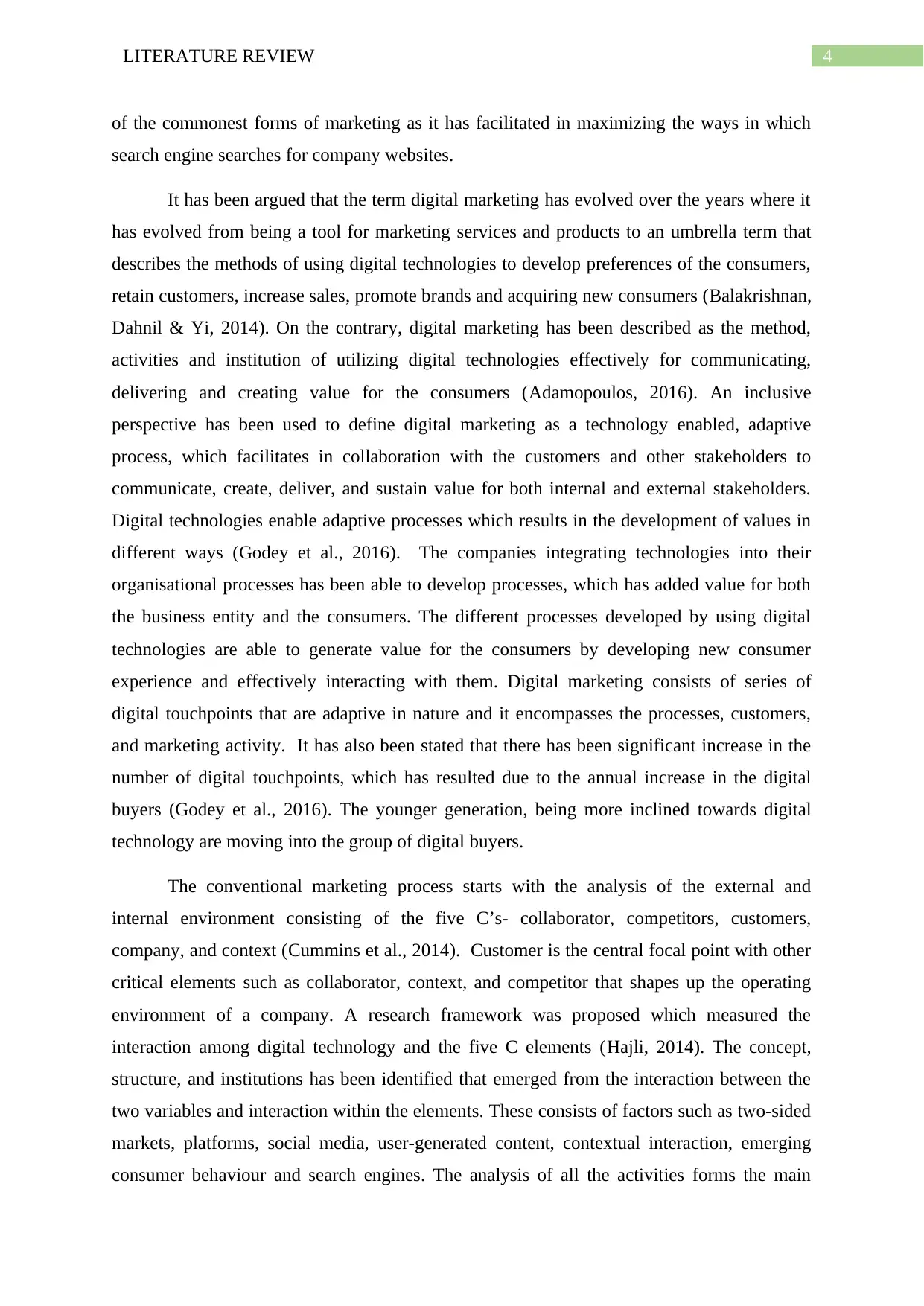
4LITERATURE REVIEW
of the commonest forms of marketing as it has facilitated in maximizing the ways in which
search engine searches for company websites.
It has been argued that the term digital marketing has evolved over the years where it
has evolved from being a tool for marketing services and products to an umbrella term that
describes the methods of using digital technologies to develop preferences of the consumers,
retain customers, increase sales, promote brands and acquiring new consumers (Balakrishnan,
Dahnil & Yi, 2014). On the contrary, digital marketing has been described as the method,
activities and institution of utilizing digital technologies effectively for communicating,
delivering and creating value for the consumers (Adamopoulos, 2016). An inclusive
perspective has been used to define digital marketing as a technology enabled, adaptive
process, which facilitates in collaboration with the customers and other stakeholders to
communicate, create, deliver, and sustain value for both internal and external stakeholders.
Digital technologies enable adaptive processes which results in the development of values in
different ways (Godey et al., 2016). The companies integrating technologies into their
organisational processes has been able to develop processes, which has added value for both
the business entity and the consumers. The different processes developed by using digital
technologies are able to generate value for the consumers by developing new consumer
experience and effectively interacting with them. Digital marketing consists of series of
digital touchpoints that are adaptive in nature and it encompasses the processes, customers,
and marketing activity. It has also been stated that there has been significant increase in the
number of digital touchpoints, which has resulted due to the annual increase in the digital
buyers (Godey et al., 2016). The younger generation, being more inclined towards digital
technology are moving into the group of digital buyers.
The conventional marketing process starts with the analysis of the external and
internal environment consisting of the five C’s- collaborator, competitors, customers,
company, and context (Cummins et al., 2014). Customer is the central focal point with other
critical elements such as collaborator, context, and competitor that shapes up the operating
environment of a company. A research framework was proposed which measured the
interaction among digital technology and the five C elements (Hajli, 2014). The concept,
structure, and institutions has been identified that emerged from the interaction between the
two variables and interaction within the elements. These consists of factors such as two-sided
markets, platforms, social media, user-generated content, contextual interaction, emerging
consumer behaviour and search engines. The analysis of all the activities forms the main
of the commonest forms of marketing as it has facilitated in maximizing the ways in which
search engine searches for company websites.
It has been argued that the term digital marketing has evolved over the years where it
has evolved from being a tool for marketing services and products to an umbrella term that
describes the methods of using digital technologies to develop preferences of the consumers,
retain customers, increase sales, promote brands and acquiring new consumers (Balakrishnan,
Dahnil & Yi, 2014). On the contrary, digital marketing has been described as the method,
activities and institution of utilizing digital technologies effectively for communicating,
delivering and creating value for the consumers (Adamopoulos, 2016). An inclusive
perspective has been used to define digital marketing as a technology enabled, adaptive
process, which facilitates in collaboration with the customers and other stakeholders to
communicate, create, deliver, and sustain value for both internal and external stakeholders.
Digital technologies enable adaptive processes which results in the development of values in
different ways (Godey et al., 2016). The companies integrating technologies into their
organisational processes has been able to develop processes, which has added value for both
the business entity and the consumers. The different processes developed by using digital
technologies are able to generate value for the consumers by developing new consumer
experience and effectively interacting with them. Digital marketing consists of series of
digital touchpoints that are adaptive in nature and it encompasses the processes, customers,
and marketing activity. It has also been stated that there has been significant increase in the
number of digital touchpoints, which has resulted due to the annual increase in the digital
buyers (Godey et al., 2016). The younger generation, being more inclined towards digital
technology are moving into the group of digital buyers.
The conventional marketing process starts with the analysis of the external and
internal environment consisting of the five C’s- collaborator, competitors, customers,
company, and context (Cummins et al., 2014). Customer is the central focal point with other
critical elements such as collaborator, context, and competitor that shapes up the operating
environment of a company. A research framework was proposed which measured the
interaction among digital technology and the five C elements (Hajli, 2014). The concept,
structure, and institutions has been identified that emerged from the interaction between the
two variables and interaction within the elements. These consists of factors such as two-sided
markets, platforms, social media, user-generated content, contextual interaction, emerging
consumer behaviour and search engines. The analysis of all the activities forms the main
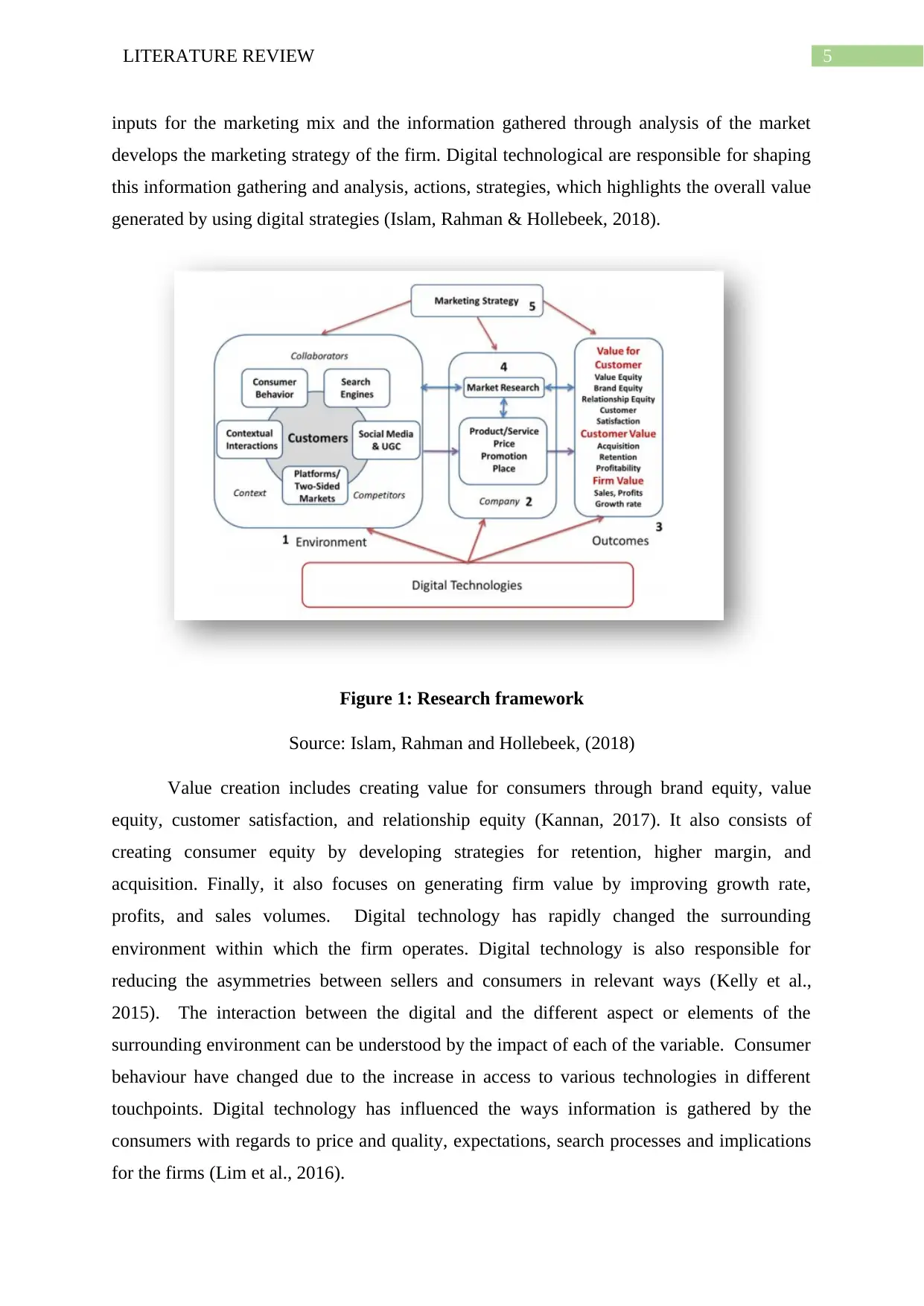
5LITERATURE REVIEW
inputs for the marketing mix and the information gathered through analysis of the market
develops the marketing strategy of the firm. Digital technological are responsible for shaping
this information gathering and analysis, actions, strategies, which highlights the overall value
generated by using digital strategies (Islam, Rahman & Hollebeek, 2018).
Figure 1: Research framework
Source: Islam, Rahman and Hollebeek, (2018)
Value creation includes creating value for consumers through brand equity, value
equity, customer satisfaction, and relationship equity (Kannan, 2017). It also consists of
creating consumer equity by developing strategies for retention, higher margin, and
acquisition. Finally, it also focuses on generating firm value by improving growth rate,
profits, and sales volumes. Digital technology has rapidly changed the surrounding
environment within which the firm operates. Digital technology is also responsible for
reducing the asymmetries between sellers and consumers in relevant ways (Kelly et al.,
2015). The interaction between the digital and the different aspect or elements of the
surrounding environment can be understood by the impact of each of the variable. Consumer
behaviour have changed due to the increase in access to various technologies in different
touchpoints. Digital technology has influenced the ways information is gathered by the
consumers with regards to price and quality, expectations, search processes and implications
for the firms (Lim et al., 2016).
inputs for the marketing mix and the information gathered through analysis of the market
develops the marketing strategy of the firm. Digital technological are responsible for shaping
this information gathering and analysis, actions, strategies, which highlights the overall value
generated by using digital strategies (Islam, Rahman & Hollebeek, 2018).
Figure 1: Research framework
Source: Islam, Rahman and Hollebeek, (2018)
Value creation includes creating value for consumers through brand equity, value
equity, customer satisfaction, and relationship equity (Kannan, 2017). It also consists of
creating consumer equity by developing strategies for retention, higher margin, and
acquisition. Finally, it also focuses on generating firm value by improving growth rate,
profits, and sales volumes. Digital technology has rapidly changed the surrounding
environment within which the firm operates. Digital technology is also responsible for
reducing the asymmetries between sellers and consumers in relevant ways (Kelly et al.,
2015). The interaction between the digital and the different aspect or elements of the
surrounding environment can be understood by the impact of each of the variable. Consumer
behaviour have changed due to the increase in access to various technologies in different
touchpoints. Digital technology has influenced the ways information is gathered by the
consumers with regards to price and quality, expectations, search processes and implications
for the firms (Lim et al., 2016).
⊘ This is a preview!⊘
Do you want full access?
Subscribe today to unlock all pages.

Trusted by 1+ million students worldwide
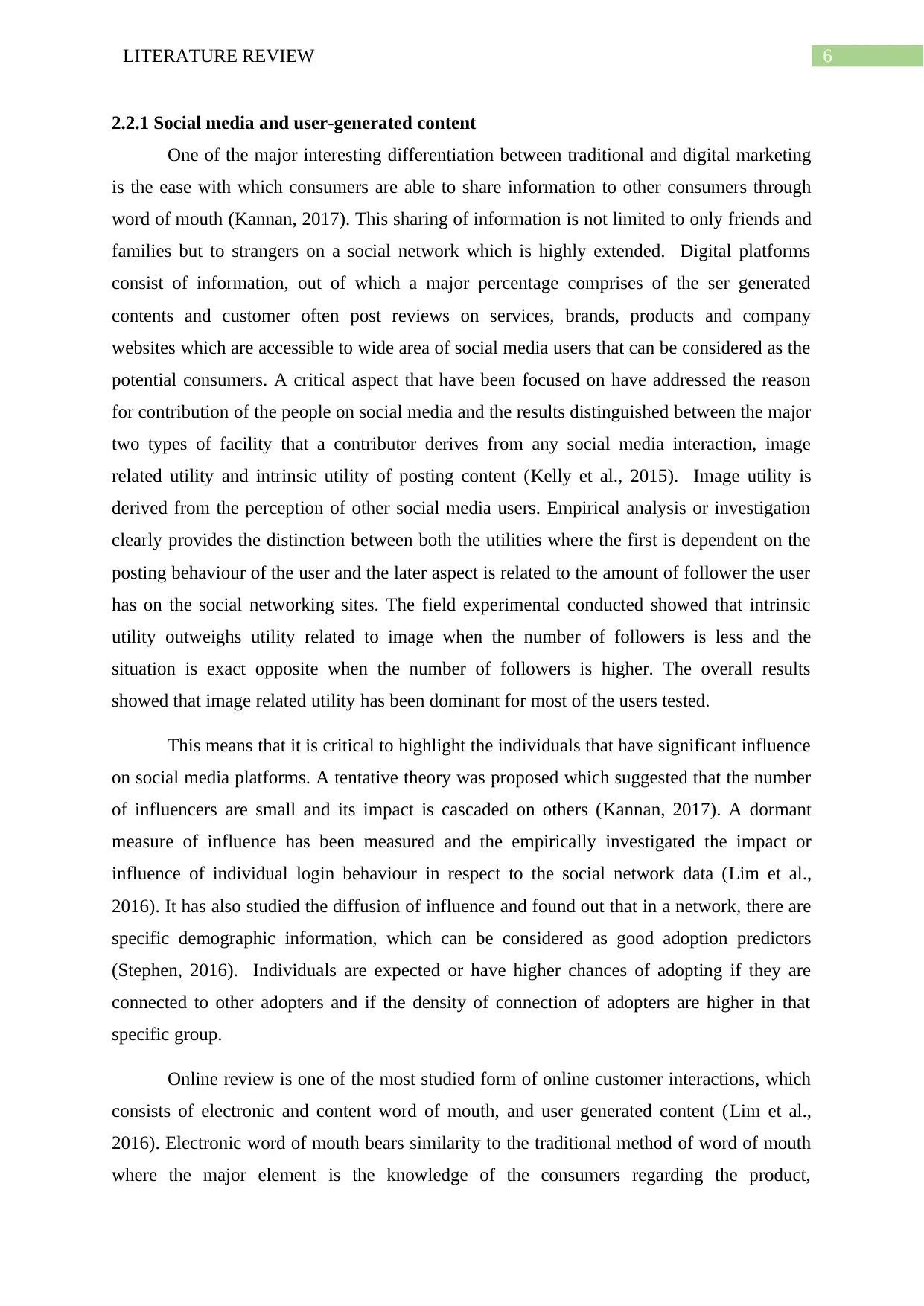
6LITERATURE REVIEW
2.2.1 Social media and user-generated content
One of the major interesting differentiation between traditional and digital marketing
is the ease with which consumers are able to share information to other consumers through
word of mouth (Kannan, 2017). This sharing of information is not limited to only friends and
families but to strangers on a social network which is highly extended. Digital platforms
consist of information, out of which a major percentage comprises of the ser generated
contents and customer often post reviews on services, brands, products and company
websites which are accessible to wide area of social media users that can be considered as the
potential consumers. A critical aspect that have been focused on have addressed the reason
for contribution of the people on social media and the results distinguished between the major
two types of facility that a contributor derives from any social media interaction, image
related utility and intrinsic utility of posting content (Kelly et al., 2015). Image utility is
derived from the perception of other social media users. Empirical analysis or investigation
clearly provides the distinction between both the utilities where the first is dependent on the
posting behaviour of the user and the later aspect is related to the amount of follower the user
has on the social networking sites. The field experimental conducted showed that intrinsic
utility outweighs utility related to image when the number of followers is less and the
situation is exact opposite when the number of followers is higher. The overall results
showed that image related utility has been dominant for most of the users tested.
This means that it is critical to highlight the individuals that have significant influence
on social media platforms. A tentative theory was proposed which suggested that the number
of influencers are small and its impact is cascaded on others (Kannan, 2017). A dormant
measure of influence has been measured and the empirically investigated the impact or
influence of individual login behaviour in respect to the social network data (Lim et al.,
2016). It has also studied the diffusion of influence and found out that in a network, there are
specific demographic information, which can be considered as good adoption predictors
(Stephen, 2016). Individuals are expected or have higher chances of adopting if they are
connected to other adopters and if the density of connection of adopters are higher in that
specific group.
Online review is one of the most studied form of online customer interactions, which
consists of electronic and content word of mouth, and user generated content (Lim et al.,
2016). Electronic word of mouth bears similarity to the traditional method of word of mouth
where the major element is the knowledge of the consumers regarding the product,
2.2.1 Social media and user-generated content
One of the major interesting differentiation between traditional and digital marketing
is the ease with which consumers are able to share information to other consumers through
word of mouth (Kannan, 2017). This sharing of information is not limited to only friends and
families but to strangers on a social network which is highly extended. Digital platforms
consist of information, out of which a major percentage comprises of the ser generated
contents and customer often post reviews on services, brands, products and company
websites which are accessible to wide area of social media users that can be considered as the
potential consumers. A critical aspect that have been focused on have addressed the reason
for contribution of the people on social media and the results distinguished between the major
two types of facility that a contributor derives from any social media interaction, image
related utility and intrinsic utility of posting content (Kelly et al., 2015). Image utility is
derived from the perception of other social media users. Empirical analysis or investigation
clearly provides the distinction between both the utilities where the first is dependent on the
posting behaviour of the user and the later aspect is related to the amount of follower the user
has on the social networking sites. The field experimental conducted showed that intrinsic
utility outweighs utility related to image when the number of followers is less and the
situation is exact opposite when the number of followers is higher. The overall results
showed that image related utility has been dominant for most of the users tested.
This means that it is critical to highlight the individuals that have significant influence
on social media platforms. A tentative theory was proposed which suggested that the number
of influencers are small and its impact is cascaded on others (Kannan, 2017). A dormant
measure of influence has been measured and the empirically investigated the impact or
influence of individual login behaviour in respect to the social network data (Lim et al.,
2016). It has also studied the diffusion of influence and found out that in a network, there are
specific demographic information, which can be considered as good adoption predictors
(Stephen, 2016). Individuals are expected or have higher chances of adopting if they are
connected to other adopters and if the density of connection of adopters are higher in that
specific group.
Online review is one of the most studied form of online customer interactions, which
consists of electronic and content word of mouth, and user generated content (Lim et al.,
2016). Electronic word of mouth bears similarity to the traditional method of word of mouth
where the major element is the knowledge of the consumers regarding the product,
Paraphrase This Document
Need a fresh take? Get an instant paraphrase of this document with our AI Paraphraser
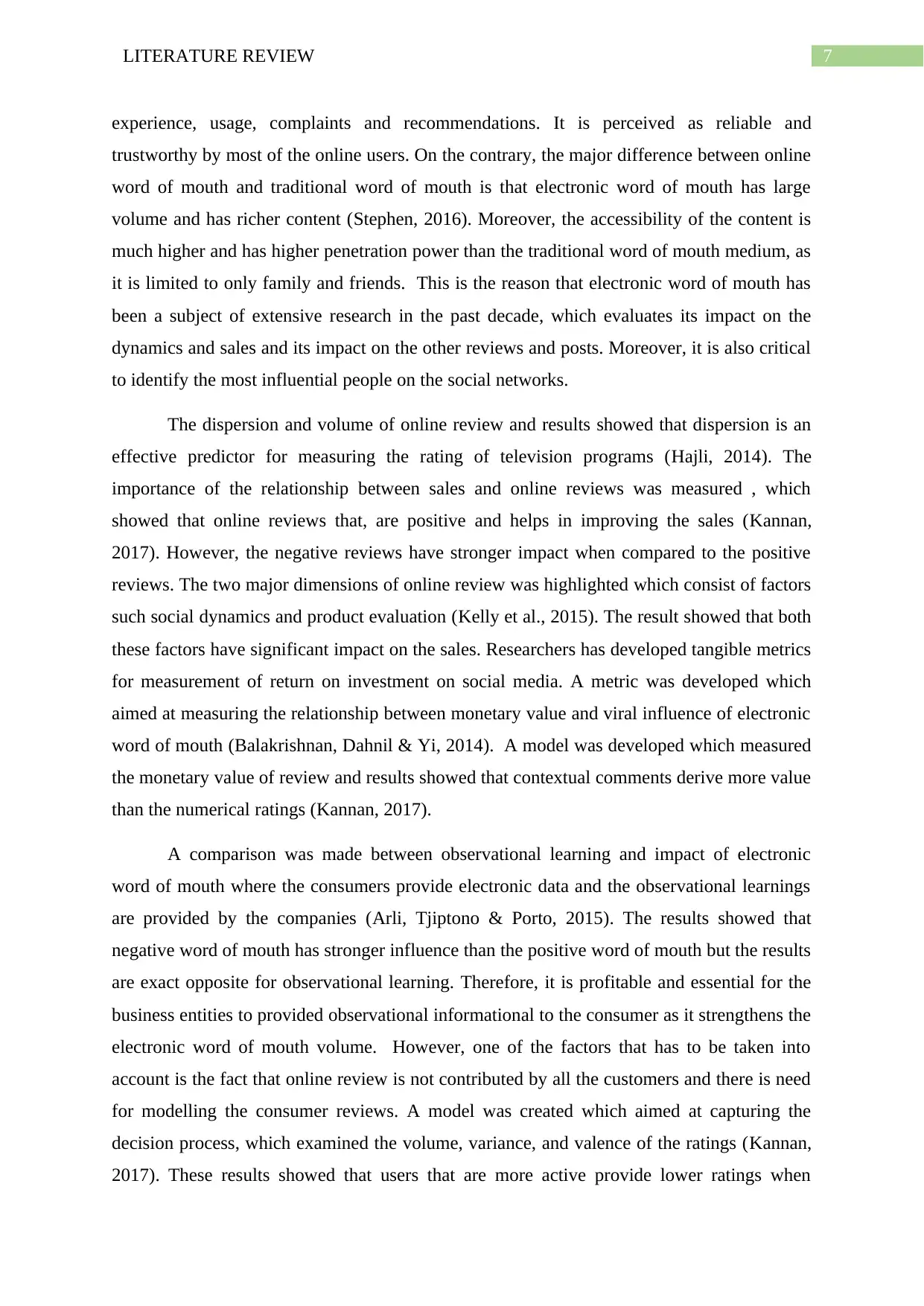
7LITERATURE REVIEW
experience, usage, complaints and recommendations. It is perceived as reliable and
trustworthy by most of the online users. On the contrary, the major difference between online
word of mouth and traditional word of mouth is that electronic word of mouth has large
volume and has richer content (Stephen, 2016). Moreover, the accessibility of the content is
much higher and has higher penetration power than the traditional word of mouth medium, as
it is limited to only family and friends. This is the reason that electronic word of mouth has
been a subject of extensive research in the past decade, which evaluates its impact on the
dynamics and sales and its impact on the other reviews and posts. Moreover, it is also critical
to identify the most influential people on the social networks.
The dispersion and volume of online review and results showed that dispersion is an
effective predictor for measuring the rating of television programs (Hajli, 2014). The
importance of the relationship between sales and online reviews was measured , which
showed that online reviews that, are positive and helps in improving the sales (Kannan,
2017). However, the negative reviews have stronger impact when compared to the positive
reviews. The two major dimensions of online review was highlighted which consist of factors
such social dynamics and product evaluation (Kelly et al., 2015). The result showed that both
these factors have significant impact on the sales. Researchers has developed tangible metrics
for measurement of return on investment on social media. A metric was developed which
aimed at measuring the relationship between monetary value and viral influence of electronic
word of mouth (Balakrishnan, Dahnil & Yi, 2014). A model was developed which measured
the monetary value of review and results showed that contextual comments derive more value
than the numerical ratings (Kannan, 2017).
A comparison was made between observational learning and impact of electronic
word of mouth where the consumers provide electronic data and the observational learnings
are provided by the companies (Arli, Tjiptono & Porto, 2015). The results showed that
negative word of mouth has stronger influence than the positive word of mouth but the results
are exact opposite for observational learning. Therefore, it is profitable and essential for the
business entities to provided observational informational to the consumer as it strengthens the
electronic word of mouth volume. However, one of the factors that has to be taken into
account is the fact that online review is not contributed by all the customers and there is need
for modelling the consumer reviews. A model was created which aimed at capturing the
decision process, which examined the volume, variance, and valence of the ratings (Kannan,
2017). These results showed that users that are more active provide lower ratings when
experience, usage, complaints and recommendations. It is perceived as reliable and
trustworthy by most of the online users. On the contrary, the major difference between online
word of mouth and traditional word of mouth is that electronic word of mouth has large
volume and has richer content (Stephen, 2016). Moreover, the accessibility of the content is
much higher and has higher penetration power than the traditional word of mouth medium, as
it is limited to only family and friends. This is the reason that electronic word of mouth has
been a subject of extensive research in the past decade, which evaluates its impact on the
dynamics and sales and its impact on the other reviews and posts. Moreover, it is also critical
to identify the most influential people on the social networks.
The dispersion and volume of online review and results showed that dispersion is an
effective predictor for measuring the rating of television programs (Hajli, 2014). The
importance of the relationship between sales and online reviews was measured , which
showed that online reviews that, are positive and helps in improving the sales (Kannan,
2017). However, the negative reviews have stronger impact when compared to the positive
reviews. The two major dimensions of online review was highlighted which consist of factors
such social dynamics and product evaluation (Kelly et al., 2015). The result showed that both
these factors have significant impact on the sales. Researchers has developed tangible metrics
for measurement of return on investment on social media. A metric was developed which
aimed at measuring the relationship between monetary value and viral influence of electronic
word of mouth (Balakrishnan, Dahnil & Yi, 2014). A model was developed which measured
the monetary value of review and results showed that contextual comments derive more value
than the numerical ratings (Kannan, 2017).
A comparison was made between observational learning and impact of electronic
word of mouth where the consumers provide electronic data and the observational learnings
are provided by the companies (Arli, Tjiptono & Porto, 2015). The results showed that
negative word of mouth has stronger influence than the positive word of mouth but the results
are exact opposite for observational learning. Therefore, it is profitable and essential for the
business entities to provided observational informational to the consumer as it strengthens the
electronic word of mouth volume. However, one of the factors that has to be taken into
account is the fact that online review is not contributed by all the customers and there is need
for modelling the consumer reviews. A model was created which aimed at capturing the
decision process, which examined the volume, variance, and valence of the ratings (Kannan,
2017). These results showed that users that are more active provide lower ratings when
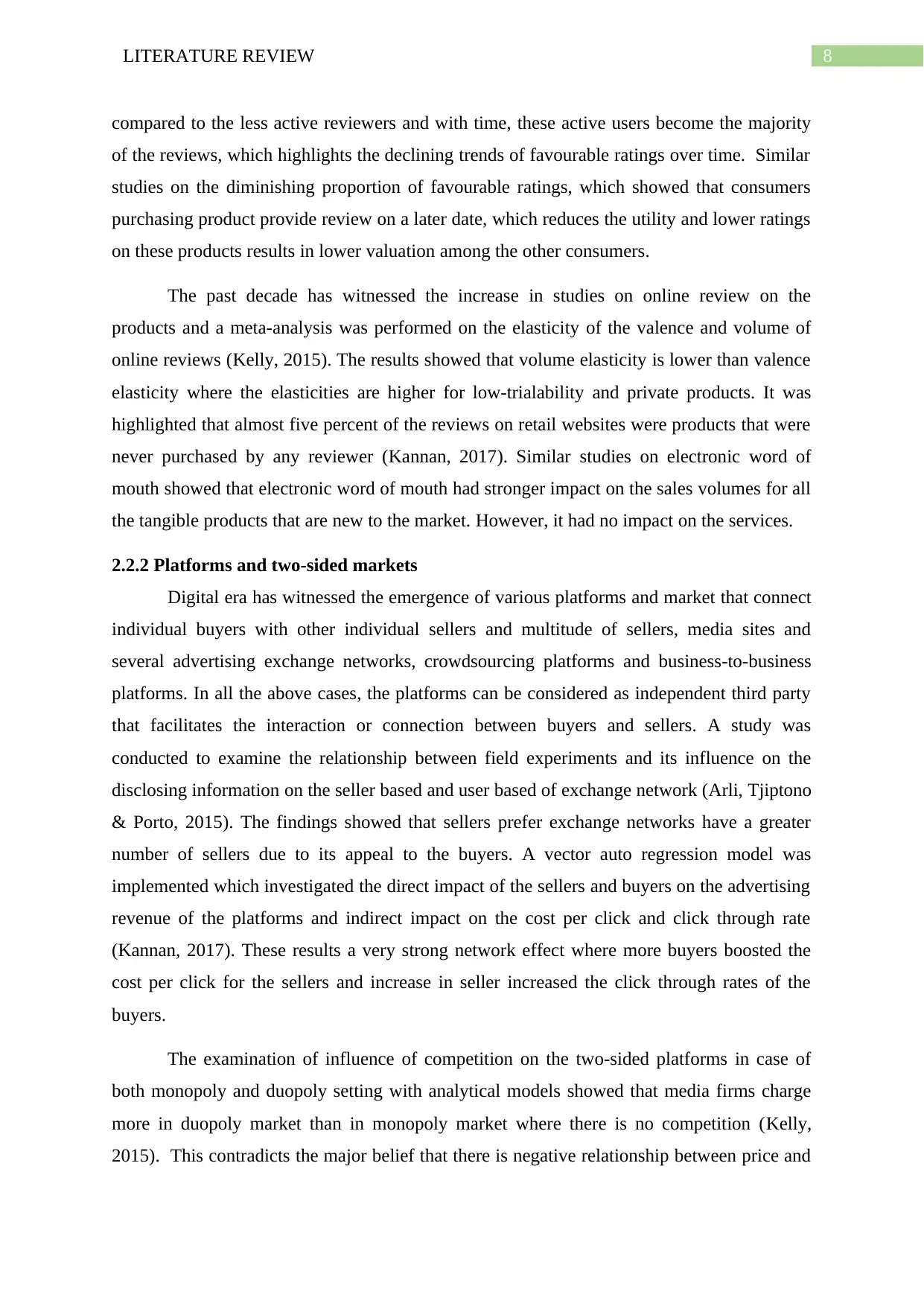
8LITERATURE REVIEW
compared to the less active reviewers and with time, these active users become the majority
of the reviews, which highlights the declining trends of favourable ratings over time. Similar
studies on the diminishing proportion of favourable ratings, which showed that consumers
purchasing product provide review on a later date, which reduces the utility and lower ratings
on these products results in lower valuation among the other consumers.
The past decade has witnessed the increase in studies on online review on the
products and a meta-analysis was performed on the elasticity of the valence and volume of
online reviews (Kelly, 2015). The results showed that volume elasticity is lower than valence
elasticity where the elasticities are higher for low-trialability and private products. It was
highlighted that almost five percent of the reviews on retail websites were products that were
never purchased by any reviewer (Kannan, 2017). Similar studies on electronic word of
mouth showed that electronic word of mouth had stronger impact on the sales volumes for all
the tangible products that are new to the market. However, it had no impact on the services.
2.2.2 Platforms and two-sided markets
Digital era has witnessed the emergence of various platforms and market that connect
individual buyers with other individual sellers and multitude of sellers, media sites and
several advertising exchange networks, crowdsourcing platforms and business-to-business
platforms. In all the above cases, the platforms can be considered as independent third party
that facilitates the interaction or connection between buyers and sellers. A study was
conducted to examine the relationship between field experiments and its influence on the
disclosing information on the seller based and user based of exchange network (Arli, Tjiptono
& Porto, 2015). The findings showed that sellers prefer exchange networks have a greater
number of sellers due to its appeal to the buyers. A vector auto regression model was
implemented which investigated the direct impact of the sellers and buyers on the advertising
revenue of the platforms and indirect impact on the cost per click and click through rate
(Kannan, 2017). These results a very strong network effect where more buyers boosted the
cost per click for the sellers and increase in seller increased the click through rates of the
buyers.
The examination of influence of competition on the two-sided platforms in case of
both monopoly and duopoly setting with analytical models showed that media firms charge
more in duopoly market than in monopoly market where there is no competition (Kelly,
2015). This contradicts the major belief that there is negative relationship between price and
compared to the less active reviewers and with time, these active users become the majority
of the reviews, which highlights the declining trends of favourable ratings over time. Similar
studies on the diminishing proportion of favourable ratings, which showed that consumers
purchasing product provide review on a later date, which reduces the utility and lower ratings
on these products results in lower valuation among the other consumers.
The past decade has witnessed the increase in studies on online review on the
products and a meta-analysis was performed on the elasticity of the valence and volume of
online reviews (Kelly, 2015). The results showed that volume elasticity is lower than valence
elasticity where the elasticities are higher for low-trialability and private products. It was
highlighted that almost five percent of the reviews on retail websites were products that were
never purchased by any reviewer (Kannan, 2017). Similar studies on electronic word of
mouth showed that electronic word of mouth had stronger impact on the sales volumes for all
the tangible products that are new to the market. However, it had no impact on the services.
2.2.2 Platforms and two-sided markets
Digital era has witnessed the emergence of various platforms and market that connect
individual buyers with other individual sellers and multitude of sellers, media sites and
several advertising exchange networks, crowdsourcing platforms and business-to-business
platforms. In all the above cases, the platforms can be considered as independent third party
that facilitates the interaction or connection between buyers and sellers. A study was
conducted to examine the relationship between field experiments and its influence on the
disclosing information on the seller based and user based of exchange network (Arli, Tjiptono
& Porto, 2015). The findings showed that sellers prefer exchange networks have a greater
number of sellers due to its appeal to the buyers. A vector auto regression model was
implemented which investigated the direct impact of the sellers and buyers on the advertising
revenue of the platforms and indirect impact on the cost per click and click through rate
(Kannan, 2017). These results a very strong network effect where more buyers boosted the
cost per click for the sellers and increase in seller increased the click through rates of the
buyers.
The examination of influence of competition on the two-sided platforms in case of
both monopoly and duopoly setting with analytical models showed that media firms charge
more in duopoly market than in monopoly market where there is no competition (Kelly,
2015). This contradicts the major belief that there is negative relationship between price and
⊘ This is a preview!⊘
Do you want full access?
Subscribe today to unlock all pages.

Trusted by 1+ million students worldwide
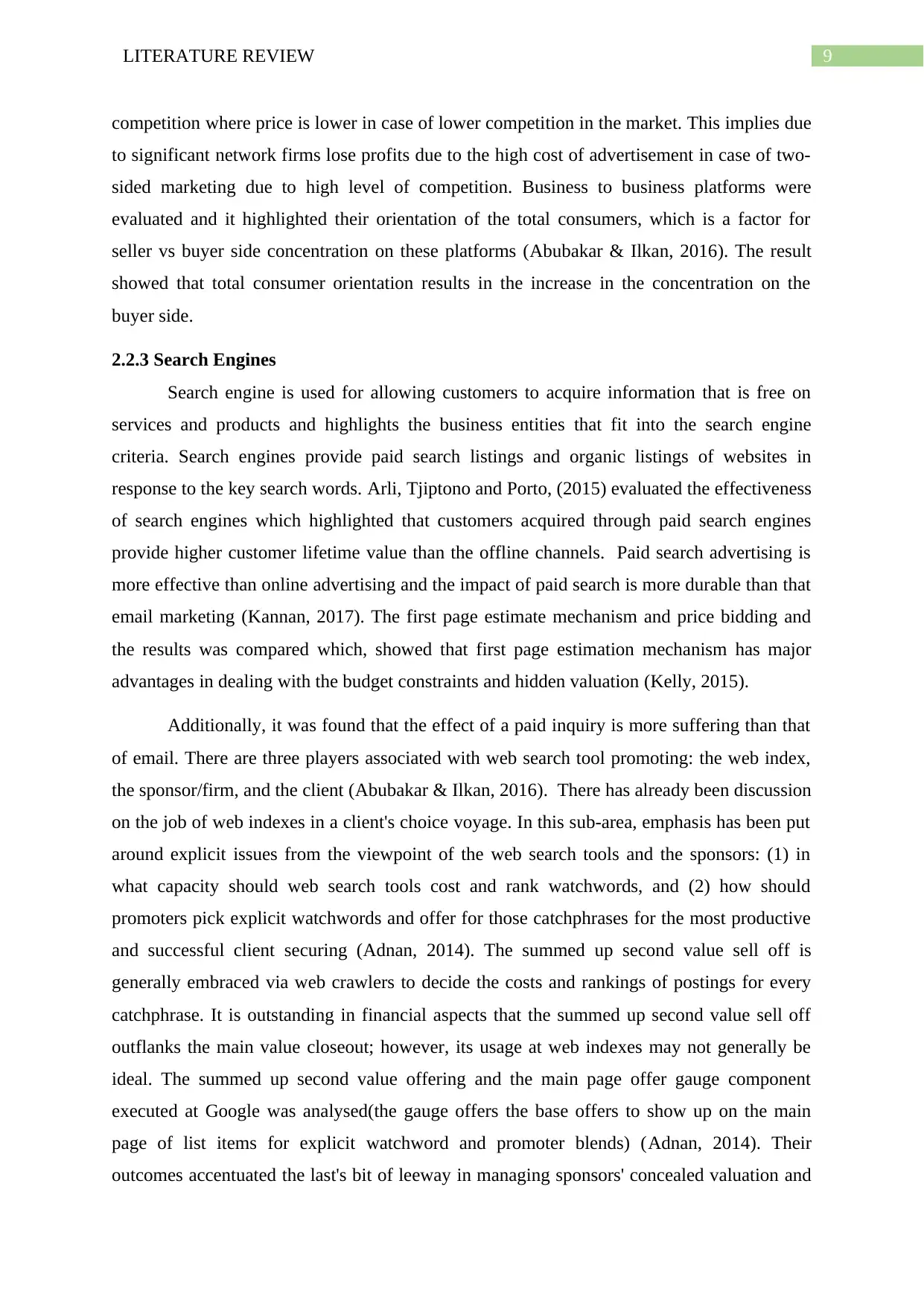
9LITERATURE REVIEW
competition where price is lower in case of lower competition in the market. This implies due
to significant network firms lose profits due to the high cost of advertisement in case of two-
sided marketing due to high level of competition. Business to business platforms were
evaluated and it highlighted their orientation of the total consumers, which is a factor for
seller vs buyer side concentration on these platforms (Abubakar & Ilkan, 2016). The result
showed that total consumer orientation results in the increase in the concentration on the
buyer side.
2.2.3 Search Engines
Search engine is used for allowing customers to acquire information that is free on
services and products and highlights the business entities that fit into the search engine
criteria. Search engines provide paid search listings and organic listings of websites in
response to the key search words. Arli, Tjiptono and Porto, (2015) evaluated the effectiveness
of search engines which highlighted that customers acquired through paid search engines
provide higher customer lifetime value than the offline channels. Paid search advertising is
more effective than online advertising and the impact of paid search is more durable than that
email marketing (Kannan, 2017). The first page estimate mechanism and price bidding and
the results was compared which, showed that first page estimation mechanism has major
advantages in dealing with the budget constraints and hidden valuation (Kelly, 2015).
Additionally, it was found that the effect of a paid inquiry is more suffering than that
of email. There are three players associated with web search tool promoting: the web index,
the sponsor/firm, and the client (Abubakar & Ilkan, 2016). There has already been discussion
on the job of web indexes in a client's choice voyage. In this sub-area, emphasis has been put
around explicit issues from the viewpoint of the web search tools and the sponsors: (1) in
what capacity should web search tools cost and rank watchwords, and (2) how should
promoters pick explicit watchwords and offer for those catchphrases for the most productive
and successful client securing (Adnan, 2014). The summed up second value sell off is
generally embraced via web crawlers to decide the costs and rankings of postings for every
catchphrase. It is outstanding in financial aspects that the summed up second value sell off
outflanks the main value closeout; however, its usage at web indexes may not generally be
ideal. The summed up second value offering and the main page offer gauge component
executed at Google was analysed(the gauge offers the base offers to show up on the main
page of list items for explicit watchword and promoter blends) (Adnan, 2014). Their
outcomes accentuated the last's bit of leeway in managing sponsors' concealed valuation and
competition where price is lower in case of lower competition in the market. This implies due
to significant network firms lose profits due to the high cost of advertisement in case of two-
sided marketing due to high level of competition. Business to business platforms were
evaluated and it highlighted their orientation of the total consumers, which is a factor for
seller vs buyer side concentration on these platforms (Abubakar & Ilkan, 2016). The result
showed that total consumer orientation results in the increase in the concentration on the
buyer side.
2.2.3 Search Engines
Search engine is used for allowing customers to acquire information that is free on
services and products and highlights the business entities that fit into the search engine
criteria. Search engines provide paid search listings and organic listings of websites in
response to the key search words. Arli, Tjiptono and Porto, (2015) evaluated the effectiveness
of search engines which highlighted that customers acquired through paid search engines
provide higher customer lifetime value than the offline channels. Paid search advertising is
more effective than online advertising and the impact of paid search is more durable than that
email marketing (Kannan, 2017). The first page estimate mechanism and price bidding and
the results was compared which, showed that first page estimation mechanism has major
advantages in dealing with the budget constraints and hidden valuation (Kelly, 2015).
Additionally, it was found that the effect of a paid inquiry is more suffering than that
of email. There are three players associated with web search tool promoting: the web index,
the sponsor/firm, and the client (Abubakar & Ilkan, 2016). There has already been discussion
on the job of web indexes in a client's choice voyage. In this sub-area, emphasis has been put
around explicit issues from the viewpoint of the web search tools and the sponsors: (1) in
what capacity should web search tools cost and rank watchwords, and (2) how should
promoters pick explicit watchwords and offer for those catchphrases for the most productive
and successful client securing (Adnan, 2014). The summed up second value sell off is
generally embraced via web crawlers to decide the costs and rankings of postings for every
catchphrase. It is outstanding in financial aspects that the summed up second value sell off
outflanks the main value closeout; however, its usage at web indexes may not generally be
ideal. The summed up second value offering and the main page offer gauge component
executed at Google was analysed(the gauge offers the base offers to show up on the main
page of list items for explicit watchword and promoter blends) (Adnan, 2014). Their
outcomes accentuated the last's bit of leeway in managing sponsors' concealed valuation and
Paraphrase This Document
Need a fresh take? Get an instant paraphrase of this document with our AI Paraphraser
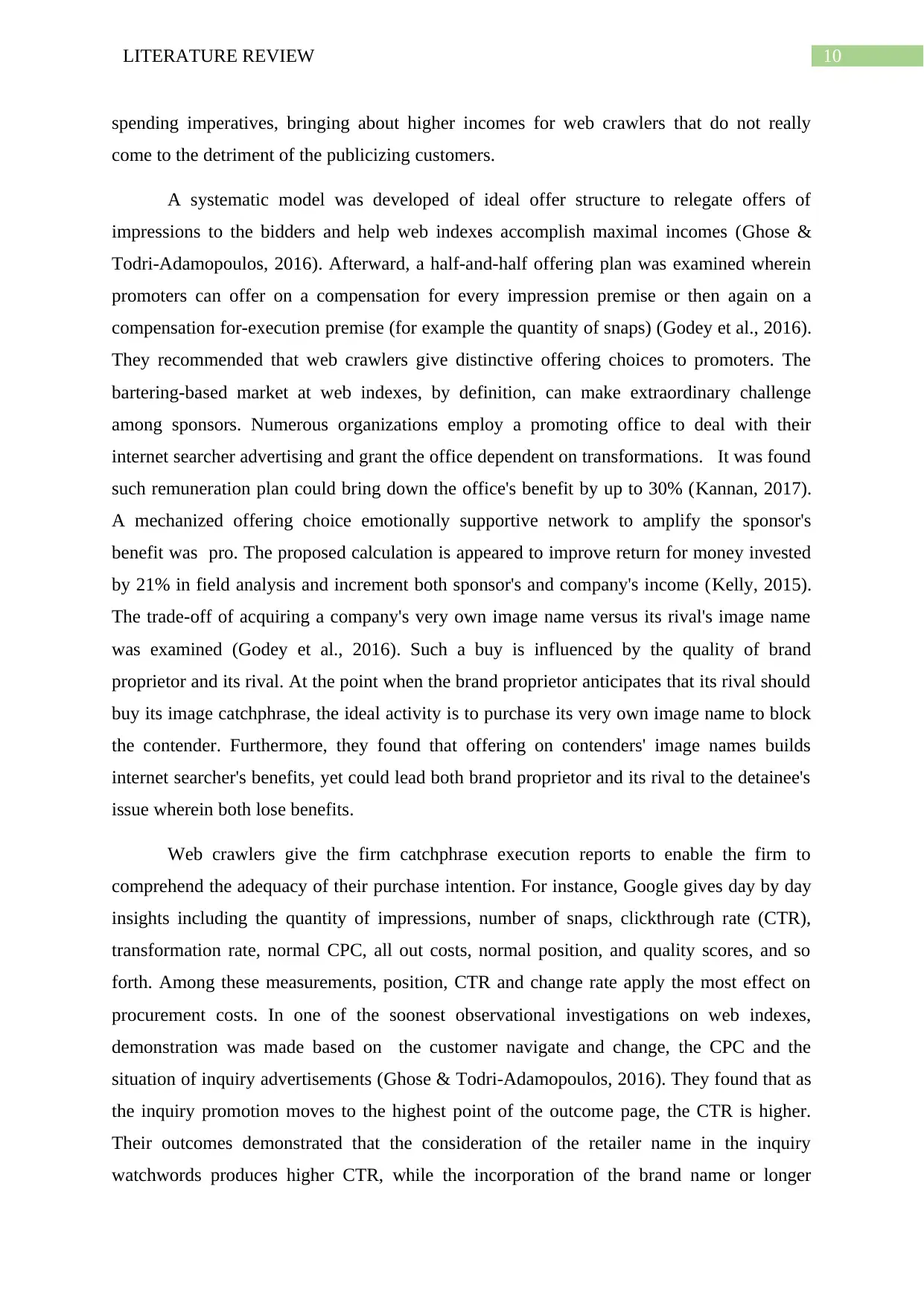
10LITERATURE REVIEW
spending imperatives, bringing about higher incomes for web crawlers that do not really
come to the detriment of the publicizing customers.
A systematic model was developed of ideal offer structure to relegate offers of
impressions to the bidders and help web indexes accomplish maximal incomes (Ghose &
Todri-Adamopoulos, 2016). Afterward, a half-and-half offering plan was examined wherein
promoters can offer on a compensation for every impression premise or then again on a
compensation for-execution premise (for example the quantity of snaps) (Godey et al., 2016).
They recommended that web crawlers give distinctive offering choices to promoters. The
bartering-based market at web indexes, by definition, can make extraordinary challenge
among sponsors. Numerous organizations employ a promoting office to deal with their
internet searcher advertising and grant the office dependent on transformations. It was found
such remuneration plan could bring down the office's benefit by up to 30% (Kannan, 2017).
A mechanized offering choice emotionally supportive network to amplify the sponsor's
benefit was pro. The proposed calculation is appeared to improve return for money invested
by 21% in field analysis and increment both sponsor's and company's income (Kelly, 2015).
The trade-off of acquiring a company's very own image name versus its rival's image name
was examined (Godey et al., 2016). Such a buy is influenced by the quality of brand
proprietor and its rival. At the point when the brand proprietor anticipates that its rival should
buy its image catchphrase, the ideal activity is to purchase its very own image name to block
the contender. Furthermore, they found that offering on contenders' image names builds
internet searcher's benefits, yet could lead both brand proprietor and its rival to the detainee's
issue wherein both lose benefits.
Web crawlers give the firm catchphrase execution reports to enable the firm to
comprehend the adequacy of their purchase intention. For instance, Google gives day by day
insights including the quantity of impressions, number of snaps, clickthrough rate (CTR),
transformation rate, normal CPC, all out costs, normal position, and quality scores, and so
forth. Among these measurements, position, CTR and change rate apply the most effect on
procurement costs. In one of the soonest observational investigations on web indexes,
demonstration was made based on the customer navigate and change, the CPC and the
situation of inquiry advertisements (Ghose & Todri-Adamopoulos, 2016). They found that as
the inquiry promotion moves to the highest point of the outcome page, the CTR is higher.
Their outcomes demonstrated that the consideration of the retailer name in the inquiry
watchwords produces higher CTR, while the incorporation of the brand name or longer
spending imperatives, bringing about higher incomes for web crawlers that do not really
come to the detriment of the publicizing customers.
A systematic model was developed of ideal offer structure to relegate offers of
impressions to the bidders and help web indexes accomplish maximal incomes (Ghose &
Todri-Adamopoulos, 2016). Afterward, a half-and-half offering plan was examined wherein
promoters can offer on a compensation for every impression premise or then again on a
compensation for-execution premise (for example the quantity of snaps) (Godey et al., 2016).
They recommended that web crawlers give distinctive offering choices to promoters. The
bartering-based market at web indexes, by definition, can make extraordinary challenge
among sponsors. Numerous organizations employ a promoting office to deal with their
internet searcher advertising and grant the office dependent on transformations. It was found
such remuneration plan could bring down the office's benefit by up to 30% (Kannan, 2017).
A mechanized offering choice emotionally supportive network to amplify the sponsor's
benefit was pro. The proposed calculation is appeared to improve return for money invested
by 21% in field analysis and increment both sponsor's and company's income (Kelly, 2015).
The trade-off of acquiring a company's very own image name versus its rival's image name
was examined (Godey et al., 2016). Such a buy is influenced by the quality of brand
proprietor and its rival. At the point when the brand proprietor anticipates that its rival should
buy its image catchphrase, the ideal activity is to purchase its very own image name to block
the contender. Furthermore, they found that offering on contenders' image names builds
internet searcher's benefits, yet could lead both brand proprietor and its rival to the detainee's
issue wherein both lose benefits.
Web crawlers give the firm catchphrase execution reports to enable the firm to
comprehend the adequacy of their purchase intention. For instance, Google gives day by day
insights including the quantity of impressions, number of snaps, clickthrough rate (CTR),
transformation rate, normal CPC, all out costs, normal position, and quality scores, and so
forth. Among these measurements, position, CTR and change rate apply the most effect on
procurement costs. In one of the soonest observational investigations on web indexes,
demonstration was made based on the customer navigate and change, the CPC and the
situation of inquiry advertisements (Ghose & Todri-Adamopoulos, 2016). They found that as
the inquiry promotion moves to the highest point of the outcome page, the CTR is higher.
Their outcomes demonstrated that the consideration of the retailer name in the inquiry
watchwords produces higher CTR, while the incorporation of the brand name or longer
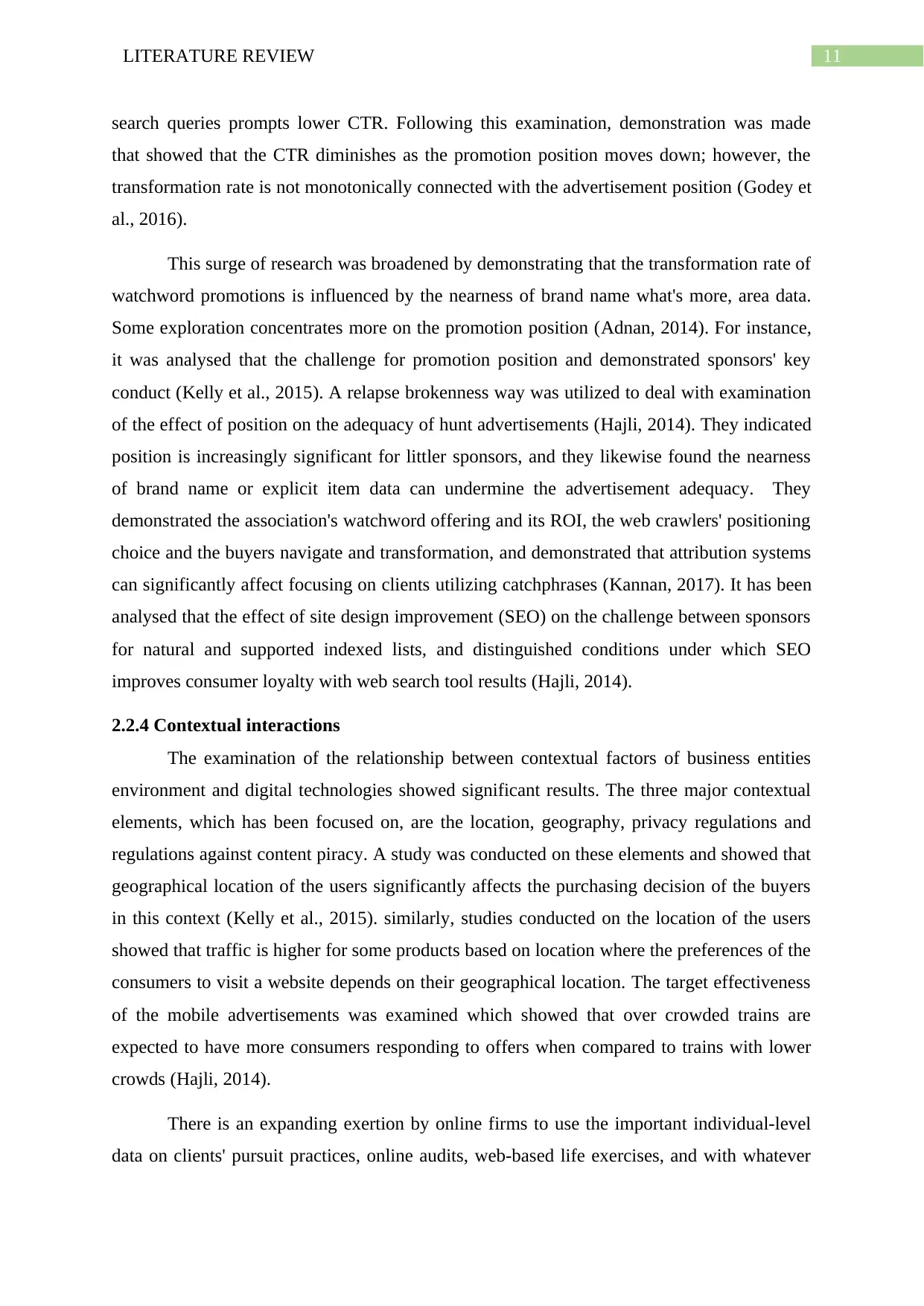
11LITERATURE REVIEW
search queries prompts lower CTR. Following this examination, demonstration was made
that showed that the CTR diminishes as the promotion position moves down; however, the
transformation rate is not monotonically connected with the advertisement position (Godey et
al., 2016).
This surge of research was broadened by demonstrating that the transformation rate of
watchword promotions is influenced by the nearness of brand name what's more, area data.
Some exploration concentrates more on the promotion position (Adnan, 2014). For instance,
it was analysed that the challenge for promotion position and demonstrated sponsors' key
conduct (Kelly et al., 2015). A relapse brokenness way was utilized to deal with examination
of the effect of position on the adequacy of hunt advertisements (Hajli, 2014). They indicated
position is increasingly significant for littler sponsors, and they likewise found the nearness
of brand name or explicit item data can undermine the advertisement adequacy. They
demonstrated the association's watchword offering and its ROI, the web crawlers' positioning
choice and the buyers navigate and transformation, and demonstrated that attribution systems
can significantly affect focusing on clients utilizing catchphrases (Kannan, 2017). It has been
analysed that the effect of site design improvement (SEO) on the challenge between sponsors
for natural and supported indexed lists, and distinguished conditions under which SEO
improves consumer loyalty with web search tool results (Hajli, 2014).
2.2.4 Contextual interactions
The examination of the relationship between contextual factors of business entities
environment and digital technologies showed significant results. The three major contextual
elements, which has been focused on, are the location, geography, privacy regulations and
regulations against content piracy. A study was conducted on these elements and showed that
geographical location of the users significantly affects the purchasing decision of the buyers
in this context (Kelly et al., 2015). similarly, studies conducted on the location of the users
showed that traffic is higher for some products based on location where the preferences of the
consumers to visit a website depends on their geographical location. The target effectiveness
of the mobile advertisements was examined which showed that over crowded trains are
expected to have more consumers responding to offers when compared to trains with lower
crowds (Hajli, 2014).
There is an expanding exertion by online firms to use the important individual-level
data on clients' pursuit practices, online audits, web-based life exercises, and with whatever
search queries prompts lower CTR. Following this examination, demonstration was made
that showed that the CTR diminishes as the promotion position moves down; however, the
transformation rate is not monotonically connected with the advertisement position (Godey et
al., 2016).
This surge of research was broadened by demonstrating that the transformation rate of
watchword promotions is influenced by the nearness of brand name what's more, area data.
Some exploration concentrates more on the promotion position (Adnan, 2014). For instance,
it was analysed that the challenge for promotion position and demonstrated sponsors' key
conduct (Kelly et al., 2015). A relapse brokenness way was utilized to deal with examination
of the effect of position on the adequacy of hunt advertisements (Hajli, 2014). They indicated
position is increasingly significant for littler sponsors, and they likewise found the nearness
of brand name or explicit item data can undermine the advertisement adequacy. They
demonstrated the association's watchword offering and its ROI, the web crawlers' positioning
choice and the buyers navigate and transformation, and demonstrated that attribution systems
can significantly affect focusing on clients utilizing catchphrases (Kannan, 2017). It has been
analysed that the effect of site design improvement (SEO) on the challenge between sponsors
for natural and supported indexed lists, and distinguished conditions under which SEO
improves consumer loyalty with web search tool results (Hajli, 2014).
2.2.4 Contextual interactions
The examination of the relationship between contextual factors of business entities
environment and digital technologies showed significant results. The three major contextual
elements, which has been focused on, are the location, geography, privacy regulations and
regulations against content piracy. A study was conducted on these elements and showed that
geographical location of the users significantly affects the purchasing decision of the buyers
in this context (Kelly et al., 2015). similarly, studies conducted on the location of the users
showed that traffic is higher for some products based on location where the preferences of the
consumers to visit a website depends on their geographical location. The target effectiveness
of the mobile advertisements was examined which showed that over crowded trains are
expected to have more consumers responding to offers when compared to trains with lower
crowds (Hajli, 2014).
There is an expanding exertion by online firms to use the important individual-level
data on clients' pursuit practices, online audits, web-based life exercises, and with whatever
⊘ This is a preview!⊘
Do you want full access?
Subscribe today to unlock all pages.

Trusted by 1+ million students worldwide
1 out of 22
Related Documents
Your All-in-One AI-Powered Toolkit for Academic Success.
+13062052269
info@desklib.com
Available 24*7 on WhatsApp / Email
![[object Object]](/_next/static/media/star-bottom.7253800d.svg)
Unlock your academic potential
Copyright © 2020–2025 A2Z Services. All Rights Reserved. Developed and managed by ZUCOL.





